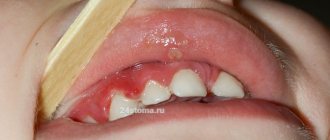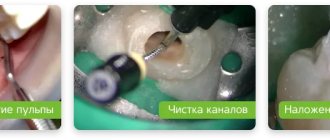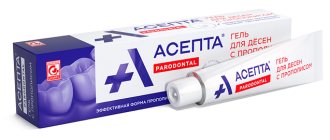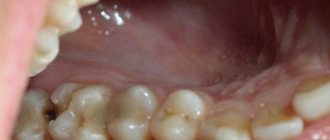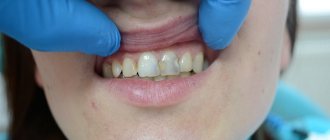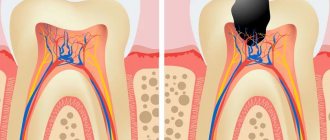Caries of the front teeth can lead to chipped enamel, severe pain and even a change in diction. In addition, it creates an aesthetic problem, as it makes the smile unattractive. If left untreated, it spreads to adjacent incisors. We will tell you why caries occurs on the front surface of the tooth, how it manifests itself and how to get rid of it.
The front teeth of a person are called 8 incisors and 4 canines, which fall into the smile zone. Any enamel damage in this area looks unaesthetic. In this case, most often the front teeth are affected by caries - a slow-moving pathological destruction of the hard tissues of the tooth (dentine).
In this article
- Causes of caries on the front teeth
- What caries looks like in the front teeth: symptoms
- Types of caries in front teeth
- Types of caries of incisors according to the form of occurrence
- Types by localization of the pathological process
- Black classification
- Diagnostics
- How to treat caries on the front teeth
- How to treat caries at an early stage
- Treatment for medium and deep stages of caries
- Treatment for severe crown lesions
- Treatment of caries of anterior teeth in children
- Complications
- Prevention of caries
The most common cause of this disease is the proliferation of cariogenic microbes. However, there are other factors leading to its development. Let us tell you why caries of the front teeth begins.
Causes of caries on the front teeth
Doctors distinguish two groups of caries factors - local and general. The first include:
- Poor oral hygiene. Lack of dental care or improper brushing leads to the formation of deposits on the enamel and gums. Over time, they accumulate and bacteria begin to multiply in them, which destroy hard tissue.
- Disruption of the salivary glands. Saliva washes germs off your teeth and neutralizes toxins created by germs in your mouth. If it is produced in insufficient quantities, the number of microorganisms increases, and the amount of their metabolic products also increases. As a result, they cause decay and damage to dentin.
- Anatomical features of the jaw and tooth structure. Their crowding leads to the rapid accumulation of plaque, as more places appear in the oral cavity that are difficult for toothbrushes to reach. An incorrect bite can also lead to tooth decay. In some cases, it becomes a consequence of carious lesions.
- Poor nutrition. The bacteria that cause tooth decay feed on carbohydrates. The more a person eats sweets, the higher the likelihood of pathology.
There are also common factors for the development of caries on the front teeth. Among them:
- Biological: heart and vascular diseases, endocrine pathologies, gastrointestinal problems, medications, weak immunity, genetic predisposition, stress.
- Environmental factors: poor ecology, unfavorable climate, drinking soft water devoid of minerals, lack of sunlight.
- Social: work in hazardous conditions, childhood, etc.
In children, caries occurs more often than in adults, in women - more often than in men, in white people - more often than in representatives of the Negroid race. This disease affects the front teeth more often than molars and premolars. This is due to the fact that the enamel on them is thinner than on chewing teeth, so they are more vulnerable to external factors and microbes. Let us tell you how caries manifests itself on the front teeth.
How does caries form?
The causes of caries are poor hygiene and the presence of bacteria in the oral cavity.
There are many bacteria in the human oral cavity. These bacteria feed on food debris that remains on the surface of the enamel after eating. Bacteria “love” foods high in carbohydrates: sweets, flour. During their life, bacteria produce acid, which destroys teeth.
Caries occurs in both adults and children. This disease spreads in each person at a different rate.
Factors contributing to the rapid development of caries:
- insufficient or lack of oral hygiene;
- excess carbohydrate foods: flour products, sweets, carbonated drinks;
- low buffering capacity of saliva, when acids and alkalis are not sufficiently neutralized in the oral cavity;
- insufficient fluorine and calcium content in enamel;
- lack of vitamins and minerals in the body;
- severe somatic pathologies suffered in childhood (tuberculosis, rickets);
- reduced immunity.
Answering a frequent question from patients: “Why do caries form on teeth?”, we note that the most important factor is insufficient hygiene. All dentists strongly recommend brushing your teeth regularly and using floss to clean the gaps. Without careful hygiene, bacteria will destroy teeth one by one, leading to serious complications.
What caries looks like in the front teeth: symptoms
Symptoms depend on the degree and type of disease. The main symptoms of incisor caries:
- sensitivity of the front teeth: accompanied by pain when the enamel is exposed to sour, sweet, hot or cold foods;
- the appearance of dark or white spots on the enamel, which indicate areas of demineralization;
- visible destruction of crowns, chips, cracks, formation of cavities that gradually increase;
- inflammation of the internal tissues of the pulp (pulpitis) or the ligaments holding the tooth in the alveolus (periodontitis);
- putrid odor from the mouth, which can only be hidden with the help of mint toothpaste or chewing gum.
At the initial stage, the disease may not manifest itself, but if any of the listed signs occur, you should consult a dentist. There are also specific symptoms characteristic of one form or another of caries. Let's look at the types of this disease.
Features of restoration
It is important not only to correct the appearance of the tooth, but also to cure the disease. At an early stage, when white or brownish spots just appear on the surface, sanding or bleaching can be done. But you don’t need to do this at home, the doctor will make the procedure much more effective and protect against complications. He can use professional grinding discs and polishers. Severe cases require the use of a drill.
Air abrasive is a more gentle processing method. It involves spraying a special substance that affects dental tissue. But this technique is not effective in all cases and is very expensive. Some clinics use laser; this is a simpler method, but requires more investment. Moreover, its effectiveness has not been proven one hundred percent; there is still debate among experts about it.
Types of caries in front teeth
Caries on the incisors is classified on several grounds. So, according to the degree of development it is:
- Beginners. An unnatural white spot can be seen on the surface of the enamel, which is a consequence of the leaching of minerals from this area of the tooth. At this stage, caries is treated with the help of remineralization - restoring the balance of minerals in the enamel structure.
- Superficial. If the initial stage of the disease is left unattended, the white spot begins to darken and becomes rough to the touch. There is increased sensitivity to sweet and sour foods, and to cold.
- Average Dark yellow or brown cavities form on the tooth. Their sizes and shapes may vary. Lack of treatment leads to the growth of pathological areas.
- Deep. The last stage of caries, which is accompanied by the destruction of hard tissues. The tooth may break into several pieces. The dark spot spreads over the entire surface of the enamel, penetrating into the dentin, so the painful sensations intensify. A tooth can hurt just like that, without being affected by food or drinks.
It is advisable to get rid of caries on the front teeth at the initial or superficial stage, because it progresses quickly in this area of the jaw.
What happens if caries is not treated?
- For a long time, the disease may not bother the patient in any way. When the destruction of hard tissue has reached a significant extent, sensitivity appears during eating.
- If you do not consult a doctor at the first stage, the carious process will go further and reach the pulp (nerve). Spontaneous severe pain appears. Treatment of pulpitis will be required.
- If the patient does not seek help at this stage, the infection spreads beyond the root. Periodontitis occurs. The prognosis here is unfavorable, since such a tooth often needs to be removed to eliminate the infection.
Therefore, timely visit to the dental clinic will help to avoid acute pain and complications.
Types of caries of incisors according to the form of occurrence
According to the form of occurrence, the following types of caries are distinguished:
- Acute: develops rapidly, in 10-14 days the disease passes through the initial, superficial and middle stages.
- Chronic: occurs slowly, gradually destroying the enamel and turning it dark. Caries takes on this form when the main factors that provoked the disease no longer affect the body, but no treatment was provided.
- Multiple: caries occurs in several places on the same tooth or on different teeth.
- Secondary: formed under an installed filling.
In this case, secondary or multiple can occur in both acute and chronic forms. For some people, caries practically does not go away, but does not bother them with pain or other symptoms. However, their teeth slowly deteriorate, increasing the risk of their removal.
Options for solving the problem
To ensure that a noticeable front tooth does not darken at all after treatment, particularly careful canal filling is important. In this case, only materials are used that preserve the natural color of the teeth.
Light seals
The filling material hardens under the influence of a special polymerizing lamp. It allows you to repeat in detail the anatomical parameters of the tooth. Provides reliable, durable filling.
Ceramic veneers
The surface of the tooth with ceramic veneers is smooth, even, without the slightest traces of treatment or restoration. Ceramics retains color, shape, is extremely strong and durable.
The original shape of pulpless teeth is often restored using ceramic crowns. They are securely attached to the stump and look as inconspicuous as possible.
Types by localization of the pathological process
Caries of the anterior teeth is localized:
- Cervical: caries begins near the neck in the gum area or under it. The main reason for this is poor oral hygiene.
- Interdental: carious lesion is observed between two incisors. Often this type of disease occurs with a small gap between them. This is where food debris gets stuck, which decomposes and causes damage to the enamel.
- Fissure: affects the grooves on the tips of the teeth. Typically, this form of the disease develops on molars, rather than on incisors and canines.
Most often, caries of the front teeth is interdental. If left untreated, the stain spreads to both incisors. If the disease starts, a hole will form between the teeth, which will be difficult to repair. At any moment, enamel and hard tissues can split into several parts.
Elimination of the disease
There are several options for treating caries; the choice of one or the other depends on the stage of its development and the financial capabilities of the patient.
Installation of veneers
Recently, this method has become very popular, especially among show business stars. It is good because with the help of special ceramic or polymer crowns you can hide all defects (shape, shade, etc.). But to install the plates, you need to grind off the dental tissue by about half and drill out all the affected areas. The custom-made veneer is then bonded using a non-toxic substance.
With high-quality installation, it can remain unchanged for up to 10-15 years.
The price of such a procedure at Dentic is about 30,000 rubles per tooth.
Crowns
They are used when the disease progresses to a deep stage and covers both sides of the incisor. They are usually made of metal and ceramics: these materials are very durable and are relatively cheap: 20 thousand rubles. But they also have a drawback: it is very difficult to choose a shade that will not stand out in the teeth. To avoid big differences, it is necessary to choose crowns made entirely of ceramic or zirconium.
Implantation
When caries destroys tissue down to the root, more serious measures must be taken. The diseased area is removed, and in its place an implant is implanted into the jaw. It is a strong rod that will hold the crown. Nowadays they make it very natural and aesthetic. The cost at Dentic starts from 30,000 rubles.
Prosthetics
There are cases when installing an implant becomes impossible, for example, when there is a risk that it will not take root, or the gums are not thick enough. Then special zirconium or ceramic prostheses are created, which are attached to adjacent units.
Treatment of caries between the front teeth with pinning
If only the root of the affected incisor remains intact, then a pin is inserted into it, having been carefully processed beforehand. It is then masked with a temporary crown for about a week while it takes root. Next they set a constant.
Black classification
American dentist Green Black developed his own classification of caries, dividing it into classes:
- 1st class: carious lesions are localized in fissures;
- 2nd class: the pathological focus is localized between the molars;
- 3rd class: caries affects the areas between the incisors and canines;
- 4th class: the disease develops along the edges of the front teeth;
- 5th class: the affected area includes the cervical area;
- 6th grade: caries affects the cutting edges of the front teeth.
During the diagnosis, the doctor determines the degree and type of caries of the front teeth, based on which he selects treatment.
About the cost of treatment
Most often, a paradoxical situation occurs: a person wants to save money on the dentist and waits until the tooth is destroyed. But you need to understand that the later you see a doctor, the more expensive his services will cost. If the problem has already appeared, it will need to be solved, and the sooner, the cheaper. Conventional preparation of a carious cavity in the early stages costs only about 4,000 rubles. If you wish to install ceramic fillings, the amount will increase to 10 thousand rubles. But some patients wait until the destruction is complete, and then they have to pay 30-50 thousand for one incisor.
We described in detail how caries of the front teeth in adults is treated. For the process to go well, it is better to choose a good private clinic. You can contact: there the work with clients is at a high level, they feel comfortable physically and psychologically. In addition, the clinic received the title of one of the best in Russia in the StartSmile rating. And on the site there are often many special offers and promotions that will significantly reduce the cost of services. Hurry up to sign up for a consultation!
Diagnostics
It is not always possible to detect caries at the initial stage, since it can be localized on the back side of the tooth. Therefore, dentists recommend coming for an oral examination every six months. During diagnosis, the doctor uses a detector staining method. It allows you to distinguish caries from other similar diseases: fluorosis, enamel hypoplasia, tetracycline teeth, etc.
The dentist can also probe the cavity to assess the nerve's response to exposure. If deep caries is suspected, the patient is sent for an x-ray of the jaw. After the examination, the type of treatment is determined.
Experts' opinion
The effectiveness of ASEPTA products has been repeatedly clinically proven. For example, according to research conducted at the Ryazan State Medical University named after Academician I.P. Pavlova of the Ministry of Health and Social Development of the Russian Federation (GBOU VPO RyazSMU Ministry of Health and Social Development of Russia), during the use of Asepta line products, a decrease in complaints of discomfort in patients is noted. Upon examination, a decrease in hyperemia and swelling of the gums was noted, but bleeding persisted upon probing.
Sources:
- Clinical experience in using the Asepta series of products Fuchs Elena Ivanovna Assistant of the Department of Therapeutic and Pediatric Dentistry State Budgetary Educational Institution of Higher Professional Education Ryazan State Medical University named after Academician I.P. Pavlova of the Ministry of Health and Social Development of the Russian Federation (GBOU VPO RyazSMU Ministry of Health and Social Development of Russia)
- Report on clinical trials to determine/confirm the preventive properties of commercially produced personal oral hygiene products: mouth rinse "ASEPTA PARODONTAL" - Solution for irrigator." Doctor of Medical Sciences Professor, Honored Doctor of the Russian Federation, Head. Department of Preventive Dentistry S.B. Ulitovsky, doctor-researcher A.A. Leontiev First St. Petersburg State Medical University named after academician I.P. Pavlova, Department of Preventive Dentistry.
- Report on determining/confirming the preventive properties of toothpaste “ASEPTA PLUS” GENTLE WHITENING” Author: doctor-researcher A.A. Leontyev, head Department of Preventive Dentistry, Doctor of Medical Sciences, Professor S.B. Ulitovsky First St. Petersburg State Medical University named after. acad. I.P. Pavlova, Department of Preventive Dentistry
Treatment for medium and deep stages of caries
Medium and deep caries are already serious lesions that cannot be eliminated with fluoride and calcium. It is necessary to drill into the tooth, clearing it of germs and dead tissue, in order to install a filling. In most cases, the procedure is performed under local anesthesia.
We list the stages of treatment:
- removal of caries-affected areas with a drill;
- disinfection of the cleaned surface;
- drying the cavity with an air stream;
- installation of a dental dam;
- layer-by-layer application of filling composition;
- grinding and polishing of the filling.
At the final stage, the patient has a paper plate inserted between the teeth to evaluate the bite. If there is any discomfort, you must inform the doctor, he will continue grinding and polishing.
Front teeth - how to remove caries if it has spread deeply
In this case, very careful treatment must be carried out. It is necessary to take an x-ray to determine the exact depth of the damage. If you make a mistake during processing, you can hit the pulp (neurovascular bundle), and it will begin to die. Typically, the dentist uses a drill and then fills the drilled area. Sometimes special tabs are used that are more resistant to external influences and are easier to chew. In this case, you do not need to drill much into the fabric to insert them, and preliminary heat treatment makes the material as durable as possible.
Treatment for severe crown lesions
If caries affects more than 50% of the incisor or canine tooth, it will not be possible to install a filling. After removing the carious areas, the patient is sent to an orthopedist for installation of an orthodontic structure: a bridge, crown, veneer or lumineer. They allow you to hide a cosmetic defect that appears after an illness.
If the tooth is completely destroyed by caries, but the root remains, the doctor installs a pin and a crown. If a tooth is completely lost, an implant will be required. This is one of the most expensive dental procedures.
Features of treatment of carious damage to anterior teeth
Caries on the frontal part is clearly visible. This is very convenient for diagnosing the disease, but significantly complicates the process of its treatment.
In such a situation, the dentist is required to have the maximum level of professionalism, since a number of specific factors have to be taken into account:
- the need to maintain an attractive appearance of teeth;
- even the slightest flaws will be clearly visible;
- thinner and more fragile tooth enamel;
- increased sensitivity of teeth.
The teeth in front are often crowded together, with small or no gaps between them. This further complicates the dentist’s work, especially in the case of interdental caries.
Treatment of caries of anterior teeth in children
Treatment of caries in children and adults follows the same stages. However, children are more difficult to treat because they are afraid of doctors. Parents must properly prepare their child for a visit to the doctor. To relieve fear, experienced dentists turn treatment into a game.
Some parents believe that there is no need to treat baby teeth, since they will fall out anyway. However, this opinion is wrong. Caries can spread to soft tissues and ligaments, which subsequently affects the condition of the molar.
How to avoid getting sick
You need to regularly monitor the condition of your teeth, not only from the outside, but also from the inside. It is no coincidence that doctors advise cleaning them 2 times a day - this is required to prevent infections. But don’t forget about following your diet; you need to eat enough:
- hard vegetables and fruits (apples, carrots, cucumbers, beets, etc.);
- greens (parsley, lettuce, dill, celery);
- berries (currants, grapes, strawberries, cranberries);
- nuts (almonds, cedar, cashews);
- dairy products (cheese, cottage cheese, natural yogurt without additives);
- citrus fruits (grapefruit, lime, orange);
- seafood (fish, shrimp);
- eggs (chicken, quail);
- honey;
- water and tea without dyes (green and black).
Do not forget about the correct cleaning technique: you need to brush each unit from the gum to the cutting edge so that the dirt does not remain in the crevices and does not oxidize. It is convenient to use dental floss for this.
Prevention of caries
It is better to try to prevent tooth decay than to treat it. Adhere to the following rules:
- Brush your teeth twice a day. However, this must be done correctly. Check with your doctor about the algorithm for cleaning your mouth with a toothbrush.
- Use additional oral hygiene products: dental floss, rinses, irrigators.
- Change your toothbrush (or brush head if you use an electric model) every 3 months.
- Protect your teeth from mechanical damage. When playing sports, wear a mouth guard, do not chew nuts in the shell, etc.
- Reduce your consumption of sugary foods; Try not to eat too hot or very cold foods.
- Make an appointment with your dentist every six months for a preventive examination, even if there are no complaints.
You can avoid caries even if you have a genetic predisposition to it. You just need to monitor your dental health and not neglect the above rules. Any symptom - bad breath, pain, tooth sensitivity, bleeding gums - should be a reason for an emergency visit to the doctor.
How is caries treated?
The treatment is carried out in professional dentistry by a general practitioner and is absolutely painless. This treatment is carried out in one visit, and several teeth can be treated in one visit.
Sequence of treatment stages:
- Examination of the oral cavity. Carrying out diagnostics: a targeted diagnostic image of one tooth or computed tomography of the jaws (if multiple caries is detected during the examination). This is done in order to make an accurate diagnosis and see the volume of destroyed tissue.
- Local anesthesia: selected individually according to health conditions. Only after the desired area of the oral cavity has become numb does the doctor proceed to the next manipulations.
- Placement of isolation: the doctor places a rubber dam on the desired area - this is a latex plate that isolates the tooth from the rest of the oral cavity. The rubber dam creates comfortable conditions for the doctor, the patient, and also allows you to create dry, sterile conditions for placing a filling. This is necessary for the filling to serve for a long time and with high quality.
- Preparation of enamel, dentin: necrectomy. The doctor uses a drill to drill out the destroyed tissue.
- Treating the cavity with antiseptic solutions, applying an adhesive - a special solution that, like glue, reliably bonds hard tissue to the filling.
- Filling with light-curing materials. The anatomical shape of the tooth is restored, and the color is carefully selected.
- Polishing and grinding so that the filling does not feel different from your own teeth. Also, using special guidelines, the doctor checks whether the filling is too high or does not interfere with the normal closure of the jaws. Excess is removed, sharp edges are sanded.
- The doctor gives recommendations after treatment. If a tooth has been severely damaged by caries, then in addition to a filling, an orthopedic onlay or crown may be required. This is due to the fact that the filling is not as strong as enamel. Over time, cracks and chips are possible. Orthopedic structures will help protect the treated tooth from these complications.
After these stages, the tooth is completely free of caries. Next, you will need to maintain regular hygiene, come for preventive examinations and professional cleaning.
Treatment methods
Modern dentistry offers a wide range of effective methods for treating caries. Depending on the stage of development of the disease, the presence of complications and other factors, gentle (not associated with the use of a drill) or filling methods can be used.
For the initial stages of caries, in which the dentin is not affected, the following treatment procedures are suitable:
- laser treatment and removal of affected tissue;
- ozone therapy, which eliminates harmful bacteria;
- Icon method (treatment with “liquid filling”);
- air abrasive treatment of the dental surface.
The key advantage of such methods is that they are non-traumatic and pain-free. The integrity of the tooth enamel is not compromised during this treatment, and the dentist manages to avoid filling. But only those types of caries that have been diagnosed in their infancy can be treated in this way.
For more advanced stages of the disease, options associated with dental fillings are used.
Basic procedures to cure caries:
- channel cleaning;
- tooth filling;
- installation of veneers;
- pin restoration;
- dental crowns, dentures and implants.
Any treatment of caries in the middle and advanced stages begins with cleansing and treatment of the dental canals. This is a complex and painstaking procedure that requires delicate and careful work of a specialist.
The dentist’s main task during cleaning is to ensure complete removal of even the smallest particles of carious tissue. If this is not done, and at least a small area of rot remains in the dental canal, then over time the disease will relapse and caries will return. The danger of this situation is that with recurrent caries, inflammation begins directly in the depths of the tooth, affecting the tissue from the inside.
After the canals are thoroughly cleaned and disinfected, the dentist chooses the further method of treatment based on the actual condition of the diseased tooth.
If the damage is minor, filling and restoration of the missing part of the tooth is performed. Much attention is paid to careful grinding of the surface and scrupulous selection of the shade of the filling material. On the front teeth, it is especially important that the restoration site does not stand out against the background of the rest of the tooth enamel. There are special shade cards that allow you to choose the perfect filling color.
Veneers are used as an alternative to conventional restoration for caries. These are special onlays that not only improve the appearance of the tooth after treatment procedures, but also protect it from damage in the future.
If the course of caries has gone too far, and there is deep damage to the dentin, there is a need for prosthetics, the manufacture of dental crowns or implants. A softer option is to install pins. The pin is used when the outer part of the tooth is destroyed, but the root is in good condition.
If your front tooth hurts after treatment
When performing treatment procedures related to cleaning canals and filling a tooth, the patient may experience pain caused by the dentist’s intervention. As a rule, the healing process occurs quite quickly, and after 1-3 days the patient stops feeling pain. To prevent inflammation and relieve wound pain, the doctor prescribes medications (for example, Nimesil).
If the pain worsens over time, you should definitely visit a dentist. There is a possibility that caries is not completely cured and an inflammatory process has begun in the canal. Repeated treatment may be required.
Complications of caries -
If the deep form of caries is not treated in time, then the infection penetrates into the pulp of the tooth. In this case, inflammation of the nerve in the tooth develops, which is called pulpitis. If, in turn, pulpitis is not treated in a timely manner, then the inflammation extends beyond the boundaries of the tooth - into the tissue surrounding the tips of the roots of the diseased tooth. In this case, granulomas or cysts (purulent sacs) appear at the tops of the roots. This disease is called periodontitis.
Is it possible to independently determine the disease?
Lateral dental caries can be determined by personally completing the following steps:
- With the help of a mirror and good lighting, you can see the color differences between the main and infected parts of the tooth. The dark spot is visible through less transparent enamel.
- Painful sensations after contact with thermal and chemical irritants.
- Unfavorable odor from the mouth. Carious bacteria, together with food debris, “trigger” the process of decay, which is accompanied by a bad aroma.
Methods for diagnosing contact caries
Visual inspection.
It is carried out during an appointment with the dentist. An old, traditional, cost-free method. But less accurate, because In some places, the dentist may not notice the early stages of caries development.
Diagnodent device
. Detection of lesions occurs by emitting special sound waves, which, reflecting from carious areas, are captured by the device. A very accurate diagnostic method.
X-ray diagnostics.
An excellent diagnostic method, because... allows you to identify carious lesions at an early stage at any location.
Treatment of the disease
Caries between teeth is treated in the same way as regular one, with the only difference being that two units have to be “fixed” at once. In some special cases, in order to get to the affected part, the dentist is obliged to get rid of healthy tooth tissue by drilling. First, the specialist must prepare the cavity and then treat it.
It is important to be careful about the process so as not to touch or even damage the nerve. After which the doctor installs a plate that separates the teeth and inserts a filling. At the end of the process, it is put in order by grinding and polishing.
Features of pathology in children
It is common for children to replace baby teeth with permanent ones, but this does not mean that temporary teeth do not need to be treated - firstly, the baby will be bothered by pain, and secondly, it is important to eliminate the source of chronic infection.
Distinctive features of caries in children:
Children need help brushing their teeth; adults must constantly monitor the process, otherwise caries may occur.
